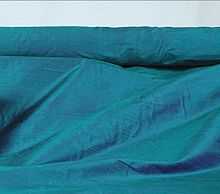Dupioni
Dupioni (also referred to as Douppioni) is a plain weave crisp type of silk fabric, produced by using fine thread in the warp and uneven thread reeled from two or more entangled cocoons in the weft. This creates tightly-woven yardage with a highly-lustrous surface. It is similar to shantung, but slightly thicker, heavier, and with a greater slub (cross-wise irregularity) count.[1]
Dupioni is often woven with differing colors of threads scattered through the warp and weft. This technique gives the fabric an iridescent effect, similar to but not as pronounced as shot silk taffeta. Dupioni can be woven into plaid and striped patterns; floral or other intrinsic, intricate designs are better suited for lighter-weight silks and/or those with smoother finishes, although dupioni may be embroidered in any manner desired.
Along with shantung, dupioni is popular in bridal and other formal wear. It is suitable for upholstery, but if it is crafted into a curtain or drape, a substantial underlining must be used to protect the fabric from sunlight.

References
Further reading
- The Fabric Style Book: Decorating with Stripes, Plaids, Florals, and More, Volume 10
- The Ultimate A to Z Companion to 1,001 Needlecraft Terms